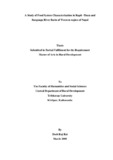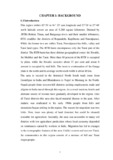Please use this identifier to cite or link to this item:
https://elibrary.tucl.edu.np/handle/123456789/2265| Title: | A Study of Food System Characterization in Rapti -Tinau and Banganga River Basin of Western Region of Nepal |
| Authors: | Rai, Deeb Raj |
| Keywords: | Food access;Exchange;Food system;Production Nutritional and social Value;Food Safety;Affordability;Allocation;Preference;Distribution |
| Issue Date: | 2008 |
| Publisher: | Central Department of Rural Development |
| Abstract: | Food system is dynamic. It interacts between and within the biogeophysical and human environments that result in the production, processing, distribution, preparation and consumption of food. Socioeconomic and biogeophysical factors both determine food security. Three principal component encompass (i) food availability (production, distribution, and exchange), (ii) food access (affordability, allocation and preference), and (iii) food utilization (nutritional value, social value, and food safety). Climate probably has the greatest effect on production and distribution. The study aimed to find out the food production under water stress and food security. Survey tools and PRA tools were used for primary data collection. A total of 303 households were surveyed, 20 FGDs were held and 10 key informants were interviewed. Gender role was discussed in 10 separate groups. Major summer crops such as paddy, sugarcane, pulses, and vegetables are exposed to floods, sand casting and erosion during the monsoon. Traditional method of farming is sensitive to water stresses. There is no regulation for crop production and no regulation for processing and packaging exists. The Price is very sensitive to water stress. Prices of commodities go up during the monsoon season and dry season. Unserviceable roads, damaged infrastructures and swollen rivers make mobility difficult during the monsoon. Food prices fluctuate depending upon the market forces. About 99 percent of the households prefer rice as staple food. To avoid storage loss, farmers' sale food immediately after harvest, save money to buy food. The stress remains sensitive to water stress for three months of the rainy season. Key words: Food system, Food access, Production Nutritional and social Value, Food Safety, Affordability, Allocation, Preference, Distribution, Exchange, |
| URI: | http://elibrary.tucl.edu.np/handle/123456789/2265 |
| Appears in Collections: | Rural Development |
Files in This Item:
| File | Description | Size | Format | |
|---|---|---|---|---|
| Cover pages.pdf | 26.1 kB | Adobe PDF |  View/Open | |
| Chapter Pages.pdf | 318.42 kB | Adobe PDF |  View/Open |
Items in DSpace are protected by copyright, with all rights reserved, unless otherwise indicated.
